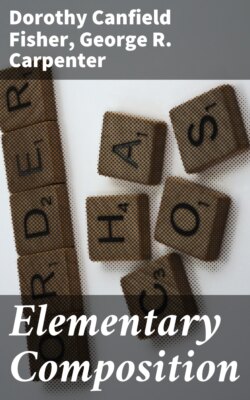Читать книгу Elementary Composition - Dorothy Canfield Fisher - Страница 4
На сайте Литреса книга снята с продажи.
TABLE OF SECTIONS
ОглавлениеTable of Contents
[The roman numerals refer to chapters; the arabic, to sections.]
| CHAPTER | PAGE | |
| I. | Introduction | 1 |
| II. | The Sentence: 1. Phrases, clauses, and sentences.—2. Simple, complex, and compound sentences.—3. Variety in the use of sentences.—4. Periodic sentences.—5. Bad sentences.—6. The "comma" sentence.—7. Sentences without unity.—8. The formless sentence | 4 |
| III. | The Paragraph: 9. The use of the paragraph.—10. The beginning.—11. Unity in the paragraph.—12. The body of the paragraph.—13. Too many paragraphs.—14. The end of a paragraph.—15. Quotations | 29 |
| IV. | Words: 16. How we learn words.—17. The size and character of the English vocabulary.—18. Increasing one's vocabulary.—19. Synonyms.—20. Accuracy in the use of words.—21. Figures of speech.—22. Mistakes in the use of words.—23. Spelling.—24. Slang.—25. Errors in the forms of words | 49 |
| V. | Condensation, Expansion, and Paraphrase: 26. Writing in which the ideas are already at hand.—27. Condensation.—28. Method in condensation.—29. Expansion.—30. The purpose of expansion.—31. Paraphrase.—32. Paraphrase of complete compositions | 69 |
| VI. | Whole Compositions; Outlines: 33. Whole compositions.—34. Outlines.—35. Essentials in a whole composition.—36. How to plan an essay | 88 |
| VII. | Oral Composition: 37. The great essential.—38. How to be heard.—39. Pronunciation.—40. A plan necessary | 102 |
| VIII. | The Diary: 41. The value of a diary.—42. Contents of a diary.—43. Imaginary diaries.—44. The class diary | 106 |
| IX. | The Letter: 45. Various kinds of letters.—46. Friendly letters.—47. Letters of social intercourse.—48. Formal invitations.—49. Telegrams.—50. Business letters.—51. Notices.—52. Appeals.—53. Petitions.—54. Advertisements | 112 |
| X. | Narration: 55. The essentials of a good narrative.—56. Autobiography.—57. Biography.—58. History.—59. Plain reporting of facts.—60. Conversation | 137 |
| XI. | Description: 61. Observation.—62. General scientific description.—63. Specific scientific description.—64. Technical terms.—65. Literary description.—66. Description of people.—67. Longer description.—68. Description of conditions.—69. Description by contrast.—70. Description of events.—71. Picture making of scenes of action.—72. Travel.—73. Descriptions of an hour | 155 |
| XII. | Narration (Continued): 74. Historical stories.—75. Fictitious stories.—76. The beginning.—77. The ending.—78. The body | 188 |
| XIII. | Exposition: 79. General principles.—80. Explanation of a material process.—81. Explanation of games.—82. Exposition of abstract ideas.—83. Exposition by example.—84. Exposition by repetition.—85. Exposition by contrast.—86. Exposition by a figure of speech | 199 |
| XIV. | Argument: 87. General principle.—88. The introduction.—89. The reasons.—90. The outline.—91. The plea.—92. Other forms | 214 |
| XV. | Secretarial Work (93) | 225 |
| XVI. | Versification (94) | 234 |
| XVII. | Punctuation: 95. General theory of punctuation.—96. The period.—97. The question mark.—98. The exclamation point.—99. The semicolon.—100. The colon.—101. The comma.—102. Parentheses and brackets.—103. The dash.—104. The apostrophe.—105. Quotation marks.—106. Italics.—107. The hyphen.—108. Capitals.—109. List of common abbreviations | 247 |
